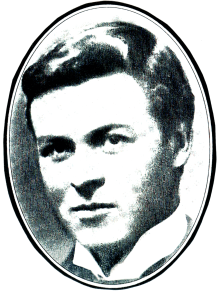
John James Joass [also known as J.J. Joass] was born in Dingwall, Scotland on 12 August 1868 and was the son of William Cumming Joass (1833-1919), a local architect. After basic training in his father's office from 1883 to 1885, he was articled to John Burnet (1814-1901), Sir John James Burnet (1857-1938), and John Archibald Campbell (1859-1938) of Burnet Son & Campbell in Glasgow from 1885 to 1890. He then worked as an assistant to Sir Robert Rowand Anderson (1834-1921) in Edinburgh from 1890 to 1893. He also studied at Glasgow School of Art. In 1893 he moved to London where he was employed as an assistant by Sir Ernest George (1839-1922) and Harold Ainsworth Peto (1854-1933) in in 1893-94: and Edward John May (1853-1941) in 1894.
Joass qualified as an architect in 1894 and in 1896 joined the London office of John Belcher (1841-1913) becoming a partner in the practice. in 1905.
Joass was elected an Associate of the Royal Institute of British Architects (ARIBA) in 1895 and a Fellow of the Royal Institute of British Architects (FRIBA) in 1912. He won the RIBA Pugin Prize and Travelling Studentship in 1892 and the RIBA Owen Jones Prize in 1895.
His address was given as 21 Hart Street, Bloomsbury Square, London in 1895; 34 John Street, Bedford Row, London in 1907; 18 Blenheim Road, London in 1912; 9 Clifford Street, London in 1912 and 1914; 10 Burlington Street, London in 1923 and 1926; ; 40 St. James Place, London in 1930 and 1939. He later moved to Poole, Dorset. He died in Wandsworth, London on 10 May 1952.
Work by Joass during his partnership with Belcher included the Ashton Memorial in Williamson Park, Lancaster (1906); the branch of Mappin & Webb in Oxford Street, London (1906-08); 26 and 28 Margaret Street, London (1907-08); the Royal Insurance building in London (1907-09); Headquarters of the British Medical Association in London (1908); the design of buildings for the Franco-British Exhibition held in London (1908); Holy Trinity church, Kingsway, London (1910); Royal Society of Medicine building, Henrietta Street, London (1910); Headquarters of the Royal Zoological Society, Regent's Park, London (1910); Whitley's, Queen's Road, London (1910); Tatmore Place, Hitchin, Hertfordshire (1910).
Following the death of Belcher in 1913, Joass practised alone. Later work by him included the War Memorial and Memorial Gardens in Ilkley, Yorkshire (1922); the rebuilding of Swan & Edgar's shop, Regent's Street and Piccadilly, London (1922); the rebuilding of Mappin & Webb's premises on Regent's Street, London (1922); Dorland House, an office block with shops in Westminster, London (1924-28); extension to the headquarters of the Institute of Chartered Accountants in England & Wales in London (1930-31).
Directory of British Architects 1834-1914. Compiled by Antonia Brodie, et al. Volume 1: A-K. London; New York: British Architectural Library, Royal Institute of British Architects/Continuum, 2001
Gray, A. Stuart. Edwardian Architecture: a Biographical Dictionary. London: Gerald Duckworth & Co., Ltd., 1985
Marriott, Charles. Modern English Architecture. London: Chapman & Hall, 1924
‘Obituary’. The Builder vol. 182, 16 May 1952 p. 748
‘Obituary’. RIBA Journal vol. 59, August 1952 pp. 385-386
Service, Alastair. 'Belcher and Joass' in Edwardian Architecture and its Origins. Edited by Alastair Service. London: The Architectural Press Limited, 1975 pp. 310-327